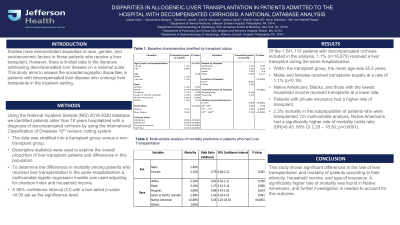Tuesday Poster Session
Category: Liver
P4599 - Disparities in Allogeneic Liver Transplantation In Patients Admitted To The Hospital With Decompensated Cirrhosis: A National Database Analysis
Tuesday, October 29, 2024
10:30 AM - 4:00 PM ET
Location: Exhibit Hall E

Has Audio

Jordan Carty, MD
Albert Einstein Medical Center
Philadelphia, PA
Presenting Author(s)
Jordan Carty, MD1, Oluwanifemi Balogun, MD1, Simone A. Jarrett, MBBS1, Jose M. Martínez Manzano, MD1, Jessica Genkil, DO2, Otoniel Ysea Hill, MD1, Kevin Robinson, MD1, Wei Yan, MD1, Manish Thapar, MD3
1Albert Einstein Medical Center, Philadelphia, PA; 2Jefferson Einstein, Huntingdon Valley, PA; 3Einstein Health, Philadelphia, PA
Introduction: End-stage liver disease is associated with high morbidity and mortality associated with liver transplantation as a curative intervention. Prior studies have demonstrated disparities in race, gender, and socioeconomic factors in those patients who receive a liver transplant. However, there is limited data in the literature addressing decompensated liver disease on a national scale. This study aims to assess the sociodemographic disparities in patients with decompensated liver disease who undergo liver transplants in the inpatient setting.
Methods: We utilized the National Inpatient Sample (NIS) 2018-2020 database. We identified patients older than 18 years hospitalized with a diagnosis of decompensated cirrhosis by using the International Classification of Diseases 10th revision coding system. We stratified the data into a transplant group versus a non-transplant group. We used descriptive statistics to explore the overall proportion of liver transplant patients and differences in this population. To determine the differences in mortality among patients who received liver transplantation in the same hospitalization, we used multivariable logistic regression models adjusting for charlson index and household income. We used a 95% confidence Interval (CI) with a two-tailed p-value < 0.05 set as the significance level.
Results: Of the 1,541,710 patients with decompensated cirrhosis included in the analysis, 1.1% (n=16,870) received a liver transplant during the same hospitalization. Within the transplant group, the mean age was 55.5 years. We observed that males and females received transplants equally at a rate of 1.1% (p=0.18). Native Americans, Blacks, and those with the lowest household income received transplants at a lower rate, while those patients with private insurance had a higher rate of transplant. Overall, there was a 2.3% mortality in the subpopulation of patients who were transplanted. On multivariable analysis, Native Americans had a significantly higher rate of mortality (odds ratio [OR]=6.43, 95% CI 2.26 – 18.30; p< 0.0001).
Discussion: This study shows significant differences in the rate of liver transplantation and mortality of patients according to their ethnicity, household income, and type of insurance. A significantly higher rate of mortality was found in Native Americans, and further investigation is needed to account for this outcome.
Note: The table for this abstract can be viewed in the ePoster Gallery section of the ACG 2024 ePoster Site or in The American Journal of Gastroenterology's abstract supplement issue, both of which will be available starting October 27, 2024.
Disclosures:
Jordan Carty, MD1, Oluwanifemi Balogun, MD1, Simone A. Jarrett, MBBS1, Jose M. Martínez Manzano, MD1, Jessica Genkil, DO2, Otoniel Ysea Hill, MD1, Kevin Robinson, MD1, Wei Yan, MD1, Manish Thapar, MD3. P4599 - Disparities in Allogeneic Liver Transplantation In Patients Admitted To The Hospital With Decompensated Cirrhosis: A National Database Analysis, ACG 2024 Annual Scientific Meeting Abstracts. Philadelphia, PA: American College of Gastroenterology.
1Albert Einstein Medical Center, Philadelphia, PA; 2Jefferson Einstein, Huntingdon Valley, PA; 3Einstein Health, Philadelphia, PA
Introduction: End-stage liver disease is associated with high morbidity and mortality associated with liver transplantation as a curative intervention. Prior studies have demonstrated disparities in race, gender, and socioeconomic factors in those patients who receive a liver transplant. However, there is limited data in the literature addressing decompensated liver disease on a national scale. This study aims to assess the sociodemographic disparities in patients with decompensated liver disease who undergo liver transplants in the inpatient setting.
Methods: We utilized the National Inpatient Sample (NIS) 2018-2020 database. We identified patients older than 18 years hospitalized with a diagnosis of decompensated cirrhosis by using the International Classification of Diseases 10th revision coding system. We stratified the data into a transplant group versus a non-transplant group. We used descriptive statistics to explore the overall proportion of liver transplant patients and differences in this population. To determine the differences in mortality among patients who received liver transplantation in the same hospitalization, we used multivariable logistic regression models adjusting for charlson index and household income. We used a 95% confidence Interval (CI) with a two-tailed p-value < 0.05 set as the significance level.
Results: Of the 1,541,710 patients with decompensated cirrhosis included in the analysis, 1.1% (n=16,870) received a liver transplant during the same hospitalization. Within the transplant group, the mean age was 55.5 years. We observed that males and females received transplants equally at a rate of 1.1% (p=0.18). Native Americans, Blacks, and those with the lowest household income received transplants at a lower rate, while those patients with private insurance had a higher rate of transplant. Overall, there was a 2.3% mortality in the subpopulation of patients who were transplanted. On multivariable analysis, Native Americans had a significantly higher rate of mortality (odds ratio [OR]=6.43, 95% CI 2.26 – 18.30; p< 0.0001).
Discussion: This study shows significant differences in the rate of liver transplantation and mortality of patients according to their ethnicity, household income, and type of insurance. A significantly higher rate of mortality was found in Native Americans, and further investigation is needed to account for this outcome.
Note: The table for this abstract can be viewed in the ePoster Gallery section of the ACG 2024 ePoster Site or in The American Journal of Gastroenterology's abstract supplement issue, both of which will be available starting October 27, 2024.
Disclosures:
Jordan Carty indicated no relevant financial relationships.
Oluwanifemi Balogun indicated no relevant financial relationships.
Simone Jarrett indicated no relevant financial relationships.
Jose Martínez Manzano indicated no relevant financial relationships.
Jessica Genkil indicated no relevant financial relationships.
Otoniel Ysea Hill indicated no relevant financial relationships.
Kevin Robinson indicated no relevant financial relationships.
Wei Yan indicated no relevant financial relationships.
Manish Thapar: Alnylam Pharaceuticals – Consultant. Disc Medicine – Consultant. Recordarti Rare Diseases – Consultant.
Jordan Carty, MD1, Oluwanifemi Balogun, MD1, Simone A. Jarrett, MBBS1, Jose M. Martínez Manzano, MD1, Jessica Genkil, DO2, Otoniel Ysea Hill, MD1, Kevin Robinson, MD1, Wei Yan, MD1, Manish Thapar, MD3. P4599 - Disparities in Allogeneic Liver Transplantation In Patients Admitted To The Hospital With Decompensated Cirrhosis: A National Database Analysis, ACG 2024 Annual Scientific Meeting Abstracts. Philadelphia, PA: American College of Gastroenterology.
